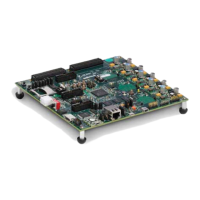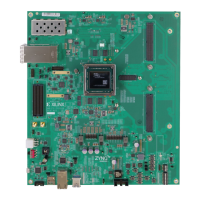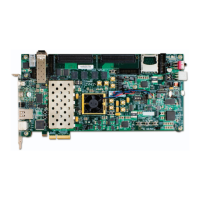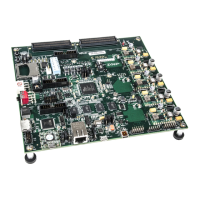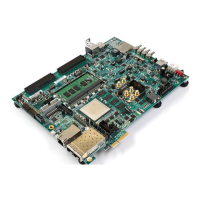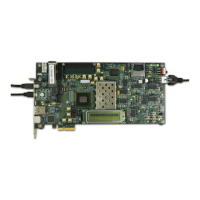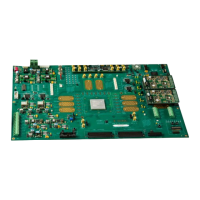Zynq-7000 AP SoC and 7 Series FPGAs MIS v4.1 346
UG586 November 30, 2016
www.xilinx.com
Chapter 2: QDR II+ Memory Interface Solution
• sys_rst – This signal is the main system reset (asynchronous).
• init_calib_complete – This signal indicates when the internal calibration is done and
that the interface is ready for use.
• tg_compare_error – This signal is generated by the example design traffic generator if
read data does not match the write data.
These signals are all set to LVCMOS25 and can be altered as needed for the system design.
They can be generated and used internally instead of being brought out to pins.
Some interfaces might need to have the system clock in a bank above or below the bank
with the address/control and data. In this case, the MIG tool puts an additional constraint in
the XDC. For example:
set_property CLOCK_DEDICATED_ROUTE BACKBONE [get_nets sys_clk_p]
set_property CLOCK_DEDICATED_ROUTE BACKBONE [get_pins -hierarchical *pll*CLKIN1]
It results in the following warning during PAR. This warning can be ignored.
WARNING:Place:1402 - A clock IOB / PLL clock component pair have been found that are
not placed at an optimal clock IOB / PLL site pair. The clock IOB component
<sys_clk_p> is placed at site <IOB_X1Y76>. The corresponding PLL component
<u_backb16/u_infrastructure/plle2_i> is placed at site <PLLE2_ADV_X1Y2>. The clock
I/O can use the fast path between the IOB and the PLL if the IOB is placed on a Clock
Capable IOB site that has dedicated fast path to PLL sites within the same clock
region. You may want to analyze why this problem exists and correct it. This is
normally an ERROR but the CLOCK_DEDICATED_ROUTE constraint was applied on COMP.PIN
<sys_clk_p.PAD> allowing your design to continue. This constraint disables all clock
placer rules related to the specified COMP.PIN. The use of this override is highly
discouraged as it may lead to very poor timing results. It is recommended that this
error condition be corrected in the design.
Do not drive user clocks through the I/O clocking backbone from the region(s) containing
the MIG generated memory interface to CMT blocks in adjacent regions due to resource
limitations. For more information, see the 7Series FPGAs Clocking Resources User Guide
(UG472) [Ref 10].
The MIG tool sets the VCCAUX_IO constraint based on the data rate and voltage input
selected. The generated XDC has additional constraints as needed. For example:
# PadFunction: IO_L13P_T2_MRCC_37
set_property VCCAUX_IO DONTCARE [get_ports {sys_clk_p}]
set_property IOSTANDARD DIFF_HSTL_I [get_ports {sys_clk_p}]
set_property PACKAGE_PIN K22 [get_ports {sys_clk_p}]
# PadFunction: IO_L13N_T2_MRCC_37
set_property VCCAUX_IO DONTCARE [get_ports {sys_clk_n}]
set_property IOSTANDARD DIFF_HSTL_I [get_ports {sys_clk_n}]
set_property PACKAGE_PIN J22 [get_ports {sys_clk_n}]
For more information, see the Xilinx Timing Constraints Guide (UG612) [Ref 15].

